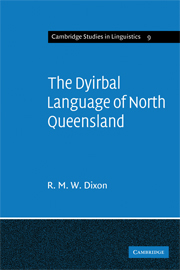Book contents
- Frontmatter
- Contents
- List of maps and plates
- Acknowledgements
- Preface
- Abbreviations and conventions
- 1 AUSTRALIAN LANGUAGES
- 2 DYIRBAL: THE LANGUAGE AND ITS SPEAKERS
- 3 WORD CLASSES
- 4 SYNTAX
- 5 DEEP SYNTAX
- 6 MORPHOLOGY
- 7 PHONOLOGY
- 8 SEMANTICS
- 9 LEXICON
- 10 PREHISTORY
- APPENDIX A DYIRBAL LOGIC
- APPENDIX B PREVIOUS WORK ON DYIRBAL
- TEXTS
- VOCABULARY
- LIST OF DYIRBAL AFFIXES
- REFERENCES
- INDEX OF AUSTRALIAN LANGUAGES
- Plate section
- Frontmatter
- Contents
- List of maps and plates
- Acknowledgements
- Preface
- Abbreviations and conventions
- 1 AUSTRALIAN LANGUAGES
- 2 DYIRBAL: THE LANGUAGE AND ITS SPEAKERS
- 3 WORD CLASSES
- 4 SYNTAX
- 5 DEEP SYNTAX
- 6 MORPHOLOGY
- 7 PHONOLOGY
- 8 SEMANTICS
- 9 LEXICON
- 10 PREHISTORY
- APPENDIX A DYIRBAL LOGIC
- APPENDIX B PREVIOUS WORK ON DYIRBAL
- TEXTS
- VOCABULARY
- LIST OF DYIRBAL AFFIXES
- REFERENCES
- INDEX OF AUSTRALIAN LANGUAGES
- Plate section
Summary
Morphology of nouns and adjectives
Stem-forming affixes. There are about a score of affixes in Dyirbal that form nominal stems from nominal roots; some of them also function as affixes to members of other word classes. Some of the affixes are important syntactically – for instance -bila ‘with’ as a type of possessive, and -gara and -maŋgan as coordinators; others merely provide semantic qualification of the noun or adjective they occur with. NPs involving certain of the affixes can make up complete sentences; this is not so in the case of other affixes.
The full functional possibilities of each affix are described below. The section ends with a discussion of the use of bound forms dayi galu, etc. (3.2.3) as nominal affixes.
[1] -ŋa This affix has already been discussed in 3.2.1 and 5.8.3. It is listed as a stem-forming affix, rather than as a case inflection, because [i] it is always optional with nouns; and [ii] it can be followed by other stem-forming affixes, -ɲ;a is generally added only to a nominal referring directly to a particular person or persons – a proper name, or else a noun used in a particular instance as a proper name.
In the case of a stem of three or more syllables ending in a vowel, ergative and dative inflections coincide; thus burbulagu is ambiguous – it could be either ergative or dative. Now a considerable proportion of proper names are of three or more syllables, and are thus open to this ambiguity. […]
- Type
- Chapter
- Information
- The Dyirbal Language of North Queensland , pp. 221 - 268Publisher: Cambridge University PressPrint publication year: 1972



